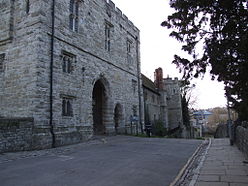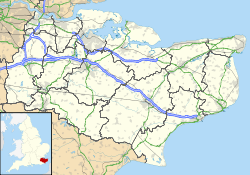- College of All Saints, Maidstone
-
College of All Saints
The College GatewayGeneral information Town or city Maidstone Country England Coordinates 51°16′12″N 0°31′18″E / 51.2701°N 0.5217°E Completed 14th century The College of All Saints was an ecclesiastical college in Maidstone, Kent founded in 1395 by Archbishop Courtenay. It was part of the establishment of the nearby Archbishop's Palace, but was closed in 1546. The College church was the neighbouring Church of All Saints. A number of the College's buildings survive and all are listed buildings.
Contents
Establishment and dissolution
The College was founded by Archbishop of Canterbury William Courtenay in 1395.[1] Courtenay died in 1396 and the College and church were completed by his successor, Thomas Arundel. Richard II endowed the College with land and income from the Hospital of St Peter and St Paul in Maidstone and from the parishes of Linton, Farleigh, Sutton and Crundale. The College was also granted the advowsons for the parishes.[2] To cover the cost of building the College, Courtenay obtained a bull to levy a charge of fourpence in the pound on all ecclesiastical revenue raised in his archbishopric.[1][note 1]
When the College was closed in 1546 following the passing of the Chantries Act, its annual income was valued at £208 6s 2d (£72,900 as of 2011).[2][3] The church and the College were separated. The church became the parish church for the whole of Maidstone and the College's estate was granted to George Brooke, Baron Cobham but was forfeited to the Crown in 1603 when his grandson, Henry Brooke, the 11th Baron Cobham, was charged with high treason for his part in the Main Plot against James I.[1] In the reign of Charles I the College became the property of Sir Edward Henden and later passed into the family of the Earls of Romney.[1]
The College buildings were used as a farm into the 19th century, until the expansion of Maidstone led to their demolition as the neighbouring area was developed. Part of the site was developed in the late 19th century for the Cutbush Almshouses, a collection of grade II listed buildings.[4]
Buildings
The College, like the Church of All Saints, is constructed of Kentish rag-stone in the Perpendicular style. The main building, a two-storey structure with attic, was mostly built in the 14th century and served originally as the Master's house. Some later 18th century alterations have been made and later windows added. The building contains a collar beam roof and a 16th century staircase, moulded ceiling and aumbry cupboard.[5]
 College farm, 1866. The ruined gateway is in the left foreground with the Master's Tower, College Gateway and tower of All Saints Church in the background. The oast house on the left has been demolished.
College farm, 1866. The ruined gateway is in the left foreground with the Master's Tower, College Gateway and tower of All Saints Church in the background. The oast house on the left has been demolished.
The College Gateway to the north of the site is a three-storey rectangular tower with stone-ribbed vaulted archway through it. The roof is hipped, projecting above a crenellated parapet. A small turret is located in the south-west corner. Adjacent to the tower on the west side is a two-storey building that contained the College refectory, kitchen and scullery on the ground floor with a dormitory and infirmary on the first floor. On the north-west corner of this building is a small three-storey tower known as the River Tower or Muniment Tower.[6] The two-storey Master's Tower was the original access to the College from the river. a single storey structure is attached to the south side.[7] The ruined gateway stands to the south separated from the other structures by the almshouses. It consists of a pointed arch for carriages in a roughly coursed rag-stone wall flanked by buttress walls on each side.[8]
The Gateway and refectory are listed Grade I,[6] the Master's house is listed Grade II* and the Master's Tower and the ruined gatehouse are listed Grade II.[5][7][8] The College site is also a Scheduled monument with the protection covering the ruined gateway and buried remains of demolished buildings.[9]
See also
- Grade I listed buildings in Maidstone
Notes and reference
Notes
- ^ In Courtenay's time there were 240 pence in the pound. The charge was therefore equal to 1.7% of income.
References
- ^ a b c d Hasted, Edward (1798). "The town and parish of Maidstone: Churches, religious houses and charities". The History and Topographical Survey of the County of Kent. vol. 4. pp. 308–327. http://www.british-history.ac.uk/report.aspx?compid=53809. Retrieved 19 June 2011.
- ^ a b Page, William, ed (1926). "The College of Maidstone". A History of the County of Kent. vol. 2. pp. 232–33. http://www.british-history.ac.uk/report.aspx?compid=38246. Retrieved 19 June 2011.
- ^ UK CPI inflation numbers based on data available from Lawrence H. Officer (2010) "What Were the UK Earnings and Prices Then?" MeasuringWorth.
- ^ Cutbush Almshouses (1266502). National Heritage List for England. English Heritage. Retrieved 29 June 2011.
- ^ a b The College (1225072). National Heritage List for England. English Heritage. Retrieved 26 June 2011.
- ^ a b The College Gateway (All Saints Parish Room) The College Tower (1336234). National Heritage List for England. English Heritage. Retrieved 26 June 2011.
- ^ a b The Master's Tower (1086312). National Heritage List for England. English Heritage. Retrieved 29 June 2011.
- ^ a b The Ruined Gateway (1336235). National Heritage List for England. English Heritage. Retrieved 29 June 2011.
- ^ The College of All Saints (1011029). National Heritage List for England. English Heritage. Retrieved 29 June 2011.
Categories:- Maidstone (borough)
- Grade I listed buildings in Kent
- Grade II* listed buildings in Kent
- Grade II listed buildings in Kent
- Scheduled Ancient Monuments in Kent
- Christianity in Kent
- Buildings and structures in Kent
Wikimedia Foundation. 2010.


